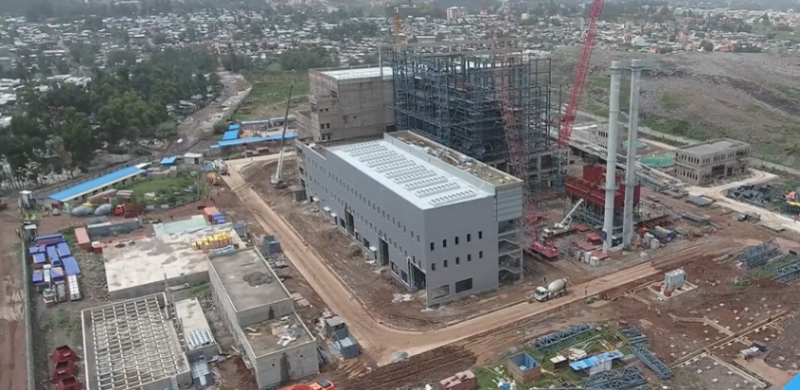
Waste-to-energy plants are already popular in Europe, as nearly 25 percent of municipal waste is incinerated.
In France alone, there are about 126 waste-to-energy plants, with Germany having 121 and Italy having 40.
The Reppie plant in Addis Ababa is the result of a partnership between the Government of Ethiopia and a consortium of international companies: Cambridge Industries Limited (Singapore), China National Electric Engineering and Ramboll, a Danish engineering firm. The consortium is hoping that the project will be a series of similar ones in major cities across Africa.
Waste management is one of the biggest challenges confronting many African countries. The issue of collection, management and disposal of solid waste still features highly in major towns and cities across the region. Failure to correctly manage waste disposal has often led to flooding and the outbreak of diseases.
In Ethiopia, its largest rubbish dump Koshe was for almost 50 years, home to hundreds of people who collect and resell rubbish trucked in from around the capital Addis Ababa. It, however, made headlines last year when it killed about 114 people, compelling the government to rethink an alternative use for the site which is said to be the size of 36 football pitches.
Ethiopia has since turned the site into a new waste-to-energy plant via the Reppie Waste-to-Energy Project which is the first of its kind in Africa. This forms part of efforts to revolutionise waste management practices in the country.
The plant, which was expected to begin operation in January, will incinerate 1,400 tons of waste every day. This represents about 80 percent of the city’s waste generation. The plant will also supply the people with 30 percent of their household electricity needs.
“The Reppie project is just one component of Ethiopia’s broader strategy to address pollution and embrace renewable energy across all sectors of the economy. We hope that Reppie will serve as a model for other countries in the region, and around the world,” Zerubabel Getachew, Ethiopia’s deputy permanent representative to the United Nations said in Nairobi last year.
The waste-to-energy incineration plant will burn the rubbish in a combustion chamber. The heat produced will be used to boil water until it turns to steam, which drives a turbine generator that produces electricity.
Waste-to-energy incineration is also vital for cities where land is in short supply, as apart from generating electricity, space will be saved and there is a substantial prevention of the release of toxic chemicals into groundwater, and reduction in the release of the greenhouse gas – methane – into the atmosphere.
The Reppie plant operates within the emissions standards of the European Union, as it contributes towards alleviating air pollution.
For half a century, the Koshe dump site has been the only landfill in Addis Ababa. As the city has expanded, the landfill – which used to lie on the outskirts of the Ethiopian capital – has become part of the urban landscape, sprawling over an area the size of 36 football pitches and attracting hundreds of waste pickers who make their living from salvaged trash. Earlier this year, a landslide on the dump site killed 114 people, prompting the government to declare three days of mourning.
But a new waste-to-energy plant is set to transform the site and revolutionize the entire city’s approach to dealing with waste. The plant, which is due to begin operating in January, will incinerate 1,400 tons of waste every day – that’s roughly 80 per cent of the city’s rubbish – all while supplying Addis with 30 per cent of its household electricity needs and meeting European standards on air emissions.
“We hope that Reppie will serve as a model for other countries in the region, and around the world.”
The facility, which is the result of a partnership between the Government of Ethiopia and a consortium of international companies, is the first of its kind in Africa.
“The Reppie project is just one component of Ethiopia’s broader strategy to address pollution and embrace renewable energy across all sectors of the economy,” said Zerubabel Getachew, Ethiopia’s deputy permanent representative to the United Nations in Nairobi. “We hope that Reppie will serve as a model for other countries in the region, and around the world.”
In waste-to-energy incineration plants, rubbish is burned in a combustion chamber. The resulting heat is used to boil water until it turns to steam, which drives a turbine generator that produces electricity.
In cities where land is in short supply, “waste-to-energy” incineration is a quadruple win: it saves precious space, generates electricity, prevents the release of toxic chemicals into groundwater, and reduces the release of methane — a potent greenhouse gas generated in landfills — into the atmosphere.
Waste incineration is popular in Europe, where nearly one quarter of all municipal solid waste is incinerated. France alone has 126 waste-to-energy plants, while Germany has 121 and Italy 40.
Like its European counterparts, the Reppie plant operates within the strict emission limits of the European Union. The plant adopts modern back-end flue gas treatment technology to drastically reduce the release of heavy metals and dioxins produced from the burning.
The project is the result of a partnership between the Government of Ethiopia and a consortium of international companies: Cambridge Industries Limited (Singapore), China National Electric Engineering and Ramboll, a Danish engineering firm. The consortium was established to design, construct and in some cases own waste-to-energy facilities customized for Sub-Saharan Africa. Reppie is the first of what the consortium hopes will be a series of such facilities in major cities across the region.
Ethiopia will begin running Africa’s first waste-to-energy plant in early 2018 according to the United Nations environment programme website. The facility in question, the Reppie project, is built on the Koshe landfill site located on the outskirts of the capital Addis Ababa.
The dump site which had served Addis Ababa for about 50 years made news headlines in March this year after a landslide at the premises killed about 114 people – residents and scavengers – according to government records.
In the wake of the incident, the government planned relocation for persons who lived on the large area said to be the size of 36 football pitches. They moved to establish the plant with the broader objective of transforming the site and Addis Ababa’s approach to dealing with waste.
Addis Ababa continues to be a city that does not have a modest way to dispose its garbage, a draining cost to the basic dignity of the city’s rich, poor and vulnerable alike.
The plant is expected to deal with 1,400 tons of waste daily, which figure comes up to about 80% of refuse generated by Addis Ababa. It will go on to supply the capital with 30% household electricity needs whiles conforming to global standards on air emissions.
Addis Ababa’s garbage headache – Addis Standard
Addis Ababa like any booming African city has its fair share of garbage headache. The Addis Standard in holistic analysis of the city highlighted that plight in an article titled: ‘Addis Ababa: a city struggling under the weight of its failures triggers fresh minefield.’
A portion on challenges relative to garbage read: “Turn to another topic. A city with one of the highest population densities in Africa (an estimated 5,165 persons per square kilometer), is imploding from the pressure of urban migration, which is manifested in housing crisis that was characterized as “70% informal” by the UN-HABITAT. Unemployment rate stands at 21.2%.
‘The breakneck speed by which the construction of high rising buildings for the rich lack viable designs to withstand the test of a rainy season.
“Addis Ababa continues to be a city that does not have a modest way to dispose its garbage, a draining cost to the basic dignity of the city’s rich, poor and vulnerable alike.”
As a city badly in need of land, the capital in June this year out doored Africa’s first smart parking facility. The Smart Megenagna Parking is said to hold 90 cars in a space that ordinarily will hold nine cars.
The $2.2m steel facility is primarily meant to ease vehicular parking and to keep with global trends in vehicle safety. It is Africa’s first such facility and is in one of the continent’s fastest growing cities. Ethiopia is an east Africa economic giant.
The project is the result of a partnership between the Government of Ethiopia and a consortium of international companies: Cambridge Industries Limited (Singapore), China National Electric Engineering and Ramboll, a Danish engineering firm.
The consortium was established to design, construct and in some cases own waste-to-energy facilities customized for Sub-Saharan Africa. Reppie is the first of what the consortium hopes will be a series of such facilities in major cities across the region.
“The Reppie project is just one component of Ethiopia’s broader strategy to address pollution and embrace renewable energy across all sectors of the economy,” said Zerubabel Getachew, Ethiopia’s deputy permanent representative to the U.N. in Nairobi.
“We hope that Reppie will serve as a model for other countries in the region, and around the world,” he stressed.
“In waste-to-energy incineration plants, rubbish is burned in a combustion chamber. The resulting heat is used to boil water until it turns to steam, which drives a turbine generator that produces electricity,” the U.N. website explains.
The energy generation system is more popular in Europe and in cities with limited land. France leads in the area with 126 waste-to-energy plants whiles Germany and Italy follow with 99 and 40 respectively.
Here, “waste-to-energy” incineration is a quadruple win: saving land space, generating electricity, preventing the release of toxic chemicals into groundwater, and reducing the release of methane — a potent greenhouse gas generated in landfills — into the atmosphere.





